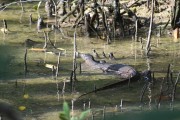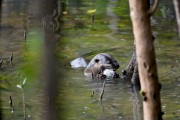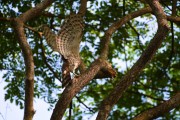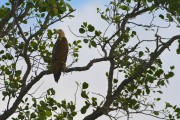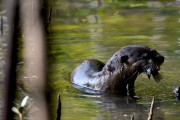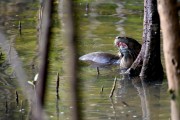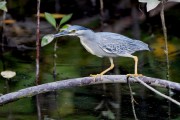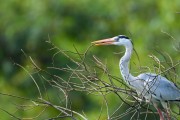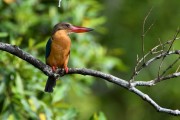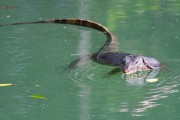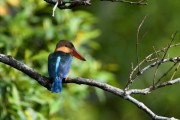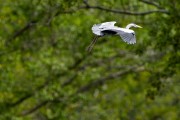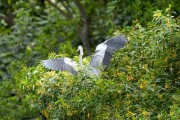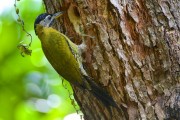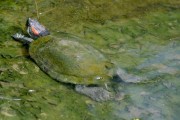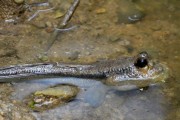Although you may dream of going on safari or photographing tigers in the jungle, one of the best places you can learn to be a better wildlife photographer is at your local park. You have the opportunity to sharpen your skills, have amazing experiences and capture beautiful images.

My local park is called Pasir Ris and it is my favourite place to photography wildlife in Singapore. There is a huge variety of wildlife in the park and there is always something to photograph. One of my favourite animals to see in the park are the otters but I also love seeing the various kingfishers, owls, hornbills and raptors. There are some wildlife like herons which I am pretty much guaranteed to see because there is a heron rookery in the park.
There are a number of things that will help you when photographing wildlife in your local park. Be prepared for your shoot, have patience when looking for wildlife, persevere when things aren’t going your way, and be flexible when capturing images.
Be Prepared
I prefer to go early in the morning as the light is beautiful. There are also fewer people around so there is a better chance of seeing wildlife. In the middle of the day, the light can be harsh and the wildlife is less active. The light in the later afternoon and evening is good but there are often more people around which affects the amount of wildlife.
For me, being prepared starts the day before I go out to capture images. I make sure my batteries are charged and I have all the equipment that I need. I check to ensure that my equipment is clean. It is important to choose the appropriate clothes for the place I’m are going. I always have long pants, long sleeve shirts and a hat to protect me from the sun and bugs. I set everything out the night before because I don’t want to waste time looking for things in the morning and possibly forgetting something.
Equipment
In terms of equipment, I always bring my Nikon 200-400mm F4 and my Nikon D500 camera. The D500 has a smaller sensor than my full frame D850 or D4S but this is an advantage. The smaller sensor means that my 200-400mm lens is like a 300-600mm lens on a full frame camera. The D500 can also capture 10 frames per second which is extremely helpful when there is a burst of action.

A high frame rate helps to capture the action
One of the things that I need to be aware of in Singapore is condensation when going from a cold environment to a warm humid one. When I first take my camera and lens out of my bag, sometimes condensation may appear on the front element of the lens. It doesn’t matter how many times I wipe it off, it will just continue to form. The only thing that works is waiting for the lens glass to warm up. So I make sure I get my lens out of my bag as soon as I arrive at the park. If I take the lens out when I first see an animal, the front element may fog up and I can’t capture any pictures.
A solid tripod is important. I use a Manfrotto 055CXPRO3 carbon fibre tripod with a Wimberley gimbal head. Although I can handhold the 200-400mm lens, I can’t do it for long and a tripod is very useful in supporting the weight of the lens. Also, there are times when I have spotted an animal like a bird on a branch and I am waiting for it to fly and it is great to be able to have the camera and lens on the tripod pointed at the subject while waiting for something to happen.
The Wimberley gimbal head makes it much easier to follow action and movement especially when it comes to birds in flight.

Using the Wimberley gimbal head allowed me to follow the flight of this stork billed kingfisher easily as it was fishing.
It can be helpful to set your camera settings before you arrive. If I am photographing wildlife, there are a few things that I change on my camera from normal shooting.
Shutter Speed mode
Usually my camera is in aperture mode where I select the aperture and the camera selects the shutter speed. However, shutter speed is really important when using a long lens like the Nikon 200-400mm F4 lens that I use for wildlife. Generally you want to use a shutter speed of at least 1 over your focal length. So that means I should be using 1/400 of a second with this lens. So I usually use shutter priority mode and set a shutter speed of 1/400 or 1/500. I may increase my shutter speed to 1/1000 or 1/2000 of a second if there is something that moves very fast and I want to freeze the movement. There are times when I am trying to capture the blur of movement and I reduce the shutter speed but I tend to lean towards freezing the movement.
Auto ISO
Along with shutter priority mode, I need to make sure that I have a high enough ISO for the situation otherwise the image can be underexposed even at the widest aperture of the lens. So I select auto ISO and select a high maximum ISO and a minimum shutter speed of 1/500.
Autofocus
I want to make sure that my images are in focus and this can be difficult if animals are moving erratically. I set my camera to dynamic autofocus where I set the focus point on the camera but the other focus points in the camera around that point are active and the camera helps to keep my subject in focus if it moves away from my selected focus point.
Patience

When it comes to wildlife photography, patience is incredibly important. You may see a bird or an animal and it may just sit there and do nothing for a long time. A kingfisher fishing may sit on a branch for a really long time and you need to be patient and prepared for the action to happen.
I have been around otters which move quickly and the experience only lasts a few minutes and I have been around them when they are resting for and not moving for long periods of time. If nothing is happening check your exposure and make sure all your settings are correct.
Once you have found an animal, wildlife photography can be a lot of waiting around for something to happen. That patience can pay off and you need to be ready for something when it does happen.
Anticipate the action
So you have seen wildlife and you have captured some images of it and now you are patiently waiting for somthing to happen. You need to make sure that you anticipate and action that might happen.

These two Tanimbar Corellas were eating seeds and nuts off the ground and seemed to be fine with each other but I was prepared if anything happened. There was something about their body language that indicated they might do something so I was ready to capture them when they did fight.
One of the things you can do is watch the animal’s body language. When a bird is going to take off, it may fluff up its feathers or stretch out. It may make little adjustments before moving and you need to be aware of these. You can’t alway look through your camera at the animal while you are waiting. Sometimes you may wait a number of minutes or even hours (if you can wait that long) for something to happen. So I have my camera on a tripod pointed at the animal but I am often not looking at the animal through my camera. I just make sure that I am closely paying attention to any changes in posture. There is nothing worse than waiting for a long time and missing the moment of action where the animals moves.
Another important thing to do when anticipating the action is to try to guess which way the animal will move. If it is a bird, you want to leave some space ahead of the bird in the direction you think it will go. If birds are up on a branch they may jump up or down to fly so look at its eyes and try to guess which way it will go. Also, if you are zoomed in too close when birds open their wings, the outer tips of their wings may get cut off on the edges of your frame. So leave some space for the bird to open its wings by zooming out a bit before it takes off.
I love having a camera with a high frame rate because it increases the number of images I can capture when something happens. That action may only last a fraction of a second so I want to shoot in bursts to give me the best chance of capturing great images.
Flexibility
It is very important that when photographing wildlife that you are flexible. I think there are two parts to flexibility: choice of subject and flexible composition.
Two of my favourite subjects in my local park at Pasir Ris in Singapore are otters and different owls. I love seeing them and every encounter is something that makes my day. But if I am completely inflexible and only try to photograph otters or owls, I am missing out on other wonderful encounters and images. I will always look for my favourite subjects, but I will also do my best to make the best images of the other wildlife that I see.
For this wildlife challenge, I captured images of a great variety of animals over the course of one morning. Take what the day gives you and make the most of your opportunities.
The second part of flexibility is being flexible with your composition. Once you have found a subject, try different compositions. This is easier if an animal is staying put in one place and not moving. Try not to just put your subject in the middle of the frame. Use the rule of thirds and put it off to one side. Make sure that you look at the background to see if there are any distractions. Sometimes a small adjustment in your position can vastly improve your image. It can be hard to think about composition when an animal is moving and things are happening fast but it is something that you can learn with practice.
It is important that you make the most of what you have. If you have a common bird that you often see, capture the best possible image of that bird that you can. Don’t just zoom as close as you can – look for other compositions.
While I often see little herons in my local park, I tried to capture the best photos that I could of this striated heron. Most of the time I default to zooming as close as I can to the animal but the composition I liked the most was when I zoomed out a little and captured this reflection. Flexibility was important in capturing this image.

Perseverance
So what happens when you have been patient and you have been flexible with your subjects but you still haven’t seen the animals that you want to see? This is where perseverance plays a role in your success. I mentioned that I love capturing images of the otters but when I first started going to my local park, I didn’t see them. I went every weekend but I just wasn’t lucky enough to be in the right place at the right time.
But after weeks and weeks of going every single weekend, I finally saw them. Persistence pays off. You may be lucky or unlucky but persistence is the great equalizer. Persistence helps you to make your own luck. The more you go the more chances you have to capture images.
I am not satisfied to see an animal once and check it off my list as something I have seen. I want to capture the best possible image that I can and I want to go see the animal again another time and try to capture even better pictures and have better encounters.
Part of being persistent and making your own luck is walking around slowly. Stop and listen. Animals will often stop moving and stop making noises when humans are nearby and if you are noisy or just walking past they will stop for a minute and then move when you are gone. Listen for the sounds around you.

I heard this otter eating a fish before I saw him. I wasn’t sure what the sounds were at first but then I spotted him having a meal amongst the trees.
Something else that can be really helpful is talking to other people if you see them. I often get tips about something that someone else has seen close by and I always return the favour and share some of the things I have seen.
Closing Thoughts
One thing that is very important is that you don’t feed wild animals and respect their space. As a photographer, you are in their environment and you need to be aware of what you are doing and if it is affecting the animals. Animals will show signs of stress if you are getting too close or if your presence is causing them distress. If you are ever unsure if you are bothering an animal, ere on the side of caution and give them space.
For this challenge, I went into the park not sure if I would see any wildlife and that is part of the excitement of photographing wild animals. You just never know what you might see. On this day I was pretty lucky as I saw number of different animals: striated heron, grey heron, crested goshawk, otter, egret, laced woodpecker, stork billed kingfisher, and a monitor lizard.
The encounters on this day didn’t represent my best ever encounters with wildlife but I enjoyed the experiences and I worked to make the best images I could. Whenever I photograph wildlife, I make sure I am prepared the night before so I am ready to go. I don’t rush when I get to the park and I try to be patient and quietly move and explore the park slowly. When I do see something I want to try to capture the best images I can of that animal and be flexible with my composition.
I hope you enjoy the video from my wildlife challenge at my local park.
